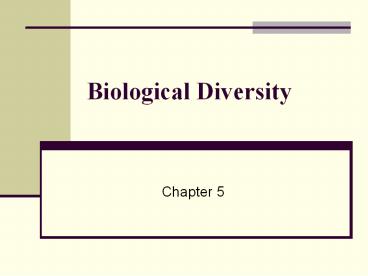Biological Diversity - PowerPoint PPT Presentation
1 / 33
Title:
Biological Diversity
Description:
Biological Diversity Chapter 5 Evolution Change in inherited characteristics of a population from generation to generation. One Way Processes Fast for some species ... – PowerPoint PPT presentation
Number of Views:287
Avg rating:3.0/5.0
Title: Biological Diversity
1
Biological Diversity
- Chapter 5
2
Evolution
- Change in inherited characteristics of a
population from generation to generation. - One Way Processes
- Fast for some species, but on average very slow
3
Evolution Occurs by
- 1. Mutation
- Genes in chromosomes hold DNA.
- DNA is reproduced each time cell divides.
- Changes occur when there is an error in
reproduction of the DNA - Affected by external agents (mutagens)
- Radiation (UV, X-rays, Gamma rays)
- Organic chemicals
- Effects
- Inability to survive
- Variation within a species
- Creation of new species (not necessarily better)!
4
Not all Mutation is Good!
5
(No Transcript)
6
2. Natural Selection
- Pressures in the environment select for traits
best suited in that environment - More likely to reproduce
- Directional changing env. conditions cause gene
frequency to shift so individuals with traits at
one end of the normal range become more common. - It pays to be different.
- Ex peppered moth, resistance to antibiotics,
pesticides
7
Graphs p.115
Peccaries prefer cacti w/few spines
8
- Stabilizing Individuals at both ends of the
range are eliminated. It pays to be average.
Good when env. doesnt change much and species is
well-adapted.
9
Peccary eat low-spine cacti insects like very
spiny ones
10
- Diversifying Env. conditions favor the extremes
of the genetic spectrum and the middle is
eliminated.
11
Tourists prefer cacti with some spines
12
3. Migration
- Movement of a species into a habitat, possibly
already occupied by that same species. Can lead
to changes in gene frequency. - Ex Seeds of flowers with red genotype dropped
into area with white genotype flowers. Can mix
genes red flowers can have new more favorable
habitat - Ex movement of Canada goose to NJ
13
(No Transcript)
14
- Genetic Drift
- Small population gets segmented away from the
rest. - Causes limited number of genes to appear,
reproduce and pass on. - Can be beneficial, but not usually. Esp.
problematic in endangered species - Traits that are less suited to the env. may
dominate - Genetic variability is reduced reduces
adaptability
15
(No Transcript)
16
4. Species Diversity
- Species Richness Total number of species in an
ecosystem. - Species Evenness How many of each type of
species is there? - Species Dominance Which species are the most
abundant.
17
- How many species are there? Anywhere from 5-30
million! - Probably around 10 million 2 million named
- 5 Kingdoms
- Plants, animals, fungi, protist, bacteria
- 3 Domains
- Eukaryotes, Bacteria and Archaea
18
(No Transcript)
19
Factors Affecting Diversity
- Increasing Diversity
- Physically diverse habitat
- Moderate disturbances
- Some variation in env. conditions
- High diversity at one trophic level affects next
- Env. highly modified by life
- Middle states of succession
- Evolution
20
- Decreasing Diversity
- Env. Stress
- Extreme Env. Conditions
- Severe limitation on essential resources
- Extreme disturbances
- Introduction of exotic species
- Geographical Isolation
21
Evolution Diversity
- Convergent Evolution
- Over time, species in similar areas develop
similar characteristics. - Ex desert biomes favor needle-shaped leaves on
plants
22
Hummingbird
Hummingbird Moth
http//home.honolulu.hawaii.edu
23
- Divergent Evolution
- A population that has been separated
geographically slowly changes to fit the new
environment
Rhea S. America
Emu Australia
Ostrich Africa
24
- Adaptive Radiation
- Many related species in one area adapted and
specialized to a particular niche in the
ecosystem - Common ancestor
- Darwins finches on the Galapagos
25
Pbs.org
26
Pop Density Distribution
- Density individuals/area
- Larger animals, lower density
- Higher density
- Use of resources
- Spread of disease
- Distribution Spatial arrangements of individuals
27
p. 127
28
Random even distribution of resources Ex
rabbits grazing on a lawn
Uniform territorial due to minimal resources Ex
Cacti
Clumped Most common. Grouped around resource,
or for protection Ex Pride of lions, schools of
fish, clover
29
Density Factors affecting Population
- Density Dependent Results depends on number of
individuals present - Spread of Disease
- Mating
- Resource Availability
- Habitat Availability
- Risk of Predation
- Density Independent Affects species no matter
how many there are - Natural Disasters
- Climate extremes
30
Survivorship curves
- Type I most likely to survive into adulthood
- Type II equal rates of death at any age
- Type III most likely to die young survival more
likely when older
31
(No Transcript)
32
Reproductive Strategies
- r-selected quantity of young, not quality
- r- rate of reproduction
- Great population flux
- live fast, die young
- Dandelions, frogs, fish
Frogs eggs
Dandelion seed
33
Reproductive Strategies (cont.)
- K-selected produce and protect relatively few
young - K-carrying capacity, often reached
- live long and prosper
- Whales, elephants, humans
Table 5.4, p132































